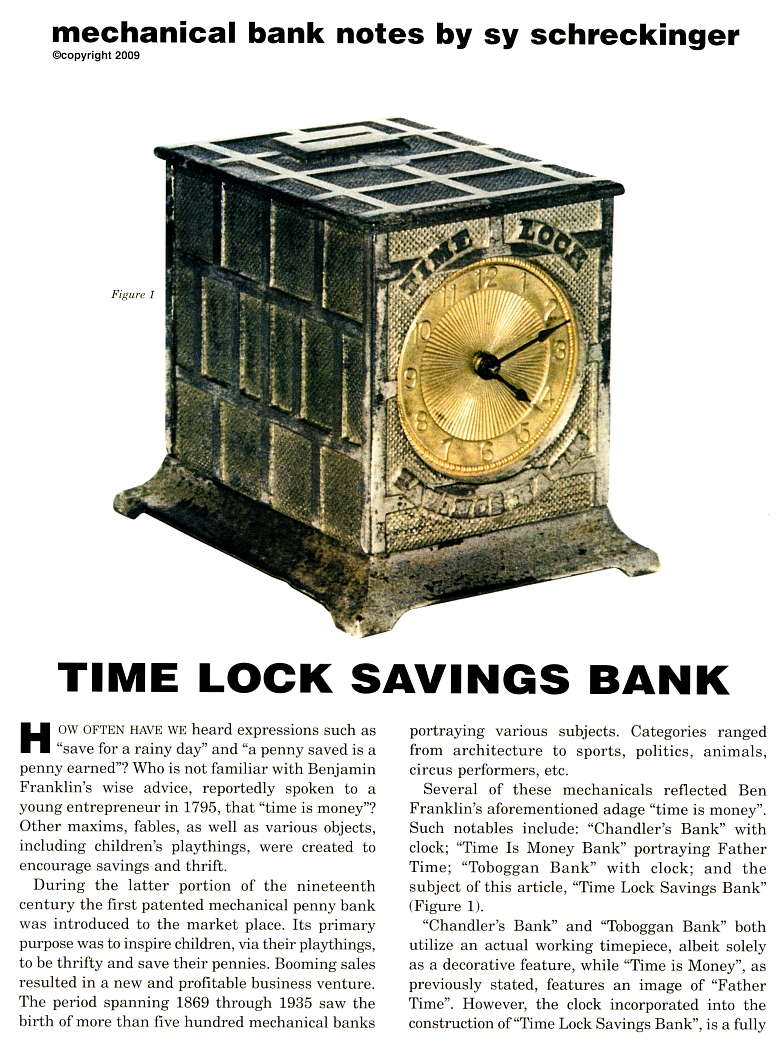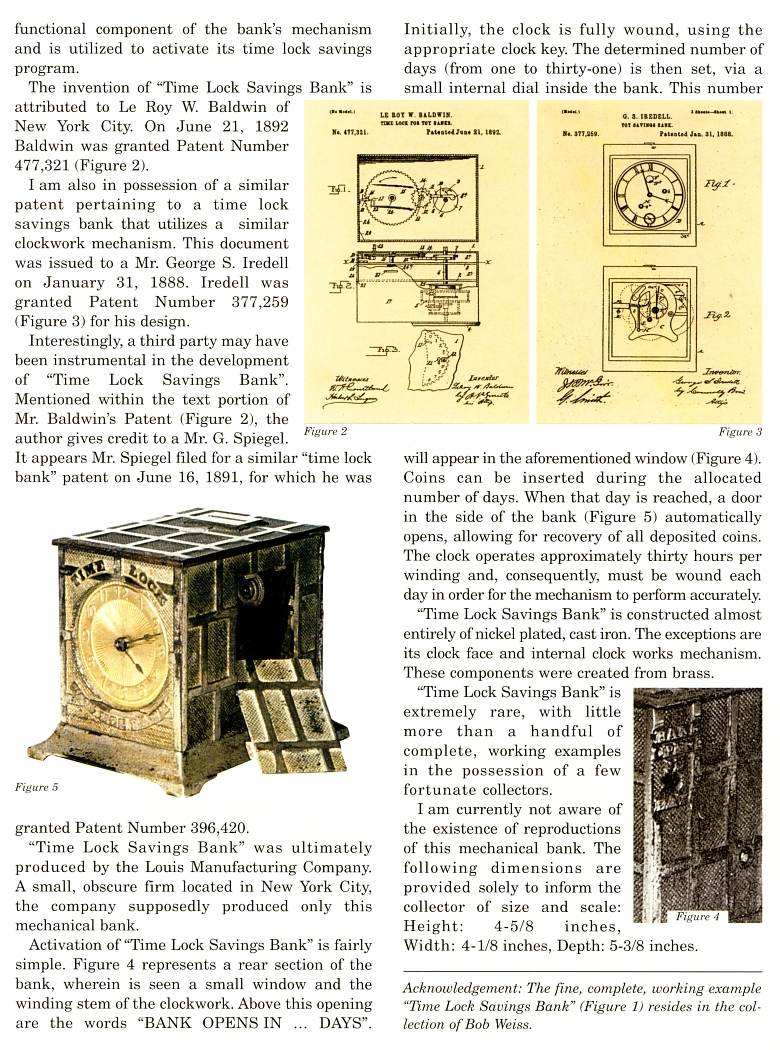|
Time Lock Savings Bank
by Sy Schreckinger – ANTIQUE TOY WORLD Magazine – February, 2009
How often have we heard expressions such as
"save for a rainy day" and "a penny saved is a penny earned"? Who is not
familiar with Benjamin Franklin's wise advice, reportedly spoken to a
young entrepreneur in 1795, that "time is money"? Other maxims, fables, as
well as various objects, including children's playthings, were created to
encourage savings and thrift.
During the latter portion of the nineteenth century the first
patented mechanical penny bank was introduced to the market place. Its
primary purpose was to inspire children, via their playthings, to be
thrifty and save their pennies. Booming sales resulted in a new and
profitable business venture. The period spanning 1869 through 1935 saw the
birth of more than five hundred mechanical banks portraying various
subjects. Categories ranged from architecture to sports, politics,
animals, circus performers, etc.
Several of these mechanicals reflected Ben Franklin's aforementioned
adage "time is money". Such notables include: "Chandler's Bank" with
clock; "Time Is Money Bank" portraying Father Time; "Toboggan Bank" with
clock; and the subject of this article, "Time Lock Savings Bank" (Figure
1).
"Chandler's Bank" and "Toboggan Bank" both utilize an actual working
timepiece, albeit solely as a decorative feature, while "Time is Money",
as previously stated, features an image of "Father Time". However, the
clock incorporated into the construction of "Time Lock Savings Bank", is a
fully functional component of the bank's mechanism and is utilized to
activate its time lock savings program.
The invention of "Time Lock Savings Bank" is attributed to Le Roy W.
Baldwin of New York City. On June 21, 1892 Baldwin was granted Patent
Number
477,321 (Figure 2).
I am also in possession of a similar patent pertaining to a time lock
savings bank that utilizes a similar clockwork mechanism. This document
was issued to a Mr. George S. Iredell on January 31, 1888. Iredell was
granted Patent Number
377,259 (Figure 3) for his design.
Interestingly, a third party may have been instrumental in the
development of "Time Lock Savings Bank". Mentioned within the text portion
of Mr. Baldwin's Patent (Figure 2), the author gives credit to a Mr. G.
Spiegel. It appears Mr. Spiegel filed for a similar "time lock bank"
patent on June 16, 1891, for which he was granted Patent Number
396,420.
"Time Lock Savings Bank" was ultimately produced by the Louis
Manufacturing Company. A small, obscure firm located in New York City, the
company supposedly produced only this mechanical bank.
Activation of "Time Lock Savings Bank" is fairly simple. Figure 4
represents a rear section of the bank, wherein is seen a small window and
the winding stem of the clockwork. Above this opening are the words "BANK
OPENS IN ... DAYS". Initially, the clock is fully wound, using the
appropriate clock key. The determined number of days (from one to
thirty-one) is then set, via a small internal dial inside the bank. This
number will appear in the aforementioned window (Figure 4). Coins can be
inserted during the allocated number of days. When that day is reached, a
door in the side of the bank (Figure 5) automatically opens, allowing for
recovery of all deposited coins. The clock operates approximately thirty
hours per winding and, consequently, must be wound each day in order for
the mechanism to perform accurately.
"Time Lock Savings Bank" is constructed almost entirely of nickel
plated, cast iron. The exceptions are its clock face and internal clock
works mechanism. These components were created from brass.
"Time Lock Savings Bank" is extremely rare, with little more than a
handful of complete, working examples in the possession of a few fortunate
collectors.
I am currently not aware of the existence of
reproductions of this mechanical bank. The following dimensions are
provided solely to inform the collector of size and scale: Height: 4-5/8
inches, Width: 4-1/8 inches, Depth: 5-3/8 inches.
Acknowledgement: The fine, complete, working example "Time Lock
Savings Bank" (Figure 1) resides in the collection of Bob Weiss.
|


